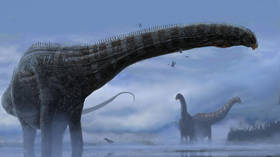Dolly the dinosaur's likely cause of death explained

The first case of a likely respiratory infection in a non-avian dinosaur has been discovered by American scientists studying the fossil of a long-necked specimen called Dolly.
Nicknamed after singer Dolly Parton, the creature was found to have abnormal bony protrusions of an irregular shape on three of its neck bones, the paleontologists said in an article in the Scientific Reports journal on Thursday.
The team, led by Cary Woodruff, director of paleontology at the Great Plains Dinosaur Museum, studied the bones using CT imaging and concluded that the protrusions were likely formed as a response to a prolonged infection in the creature’s air sacs.
“Given the likely symptoms this animal suffered from, holding these infected bones in your hands, you can't help but feel sorry for Dolly… We've all experienced these same symptoms – coughing, trouble breathing, a fever, etc. – and here's a 150-million-year-old dinosaur that likely felt as miserable as we all do when we're sick," Woodruff said in a statement.
The exact cause of the infection remains undetermined, with scientists noting it is difficult to understand dinosaur diseases with only bones and no soft tissue to study.
They assumed, however, that the most likely cause was a fungal disease similar to aspergillosis, which is the most common respiratory illness in birds and can lead to bone infection and be fatal if left untreated.
The dinosaur, aged between 15 and 20 years, contracted the disease shortly before its death, and might have died due to infection, though the scientists could not say exactly how long after falling ill Dolly met her end. It is possible that the environment of the region the dinosaur lived in contributed to the contraction and development of the illness.
The fossil, including the skull and spine of the dinosaur, was first discovered in 1990 in Montana. It was a diplodocid herbivore with a tall neck, and was about 18 meters long. The remains are estimated to be 150 million years old.
Previous research has shown that dinosaurs could suffer from cancer and infection from injuries.
Woodruff’s team expressed hope that further investigations will allow them to improve their understanding of what illnesses affected dinosaurs, to get a better understanding of their physiology and to trace and understand modern medical conditions.













